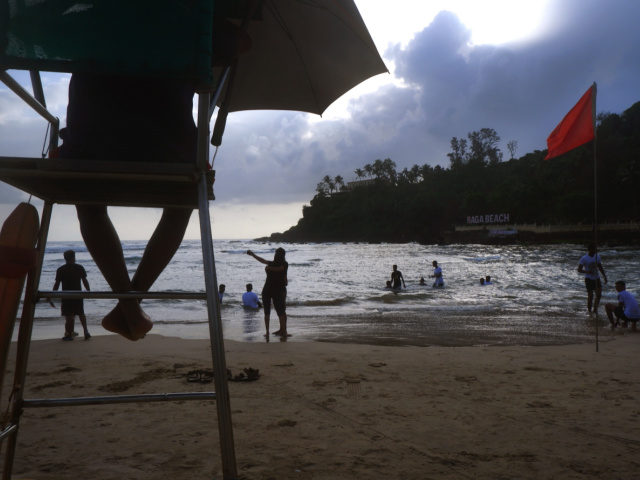The Indian state of Goa announced Monday it will shut down schools through the end of the month and implement a curfew in response to the Chinese coronavirus pandemic – just days after video showed throngs of thousands of tourists enjoying the state’s beaches.
Goa, a southern state along India’s west coast, regularly attracts thousands of tourists for New Year celebrations and extended vacations. This year was no different despite rising international concern over the omicron variant of the Chinese coronavirus, first identified in South Africa in November but present in Europe before its discovery. Last week, Indian officials documented a modest decline in cases and hospitalizations, observing that most cases still appeared to be of the delta variant of the Chinese coronavirus, which originated in the country.
As the omicron variant has begun to spread, confirmed coronavirus cases are increasing. Goa, in particular, has experienced a tourist-driven rise in cases that has now compromised the education of children who live there. Authorities reportedly documented a ten percent increase in coronavirus cases since the Christmas season began (Goa, formerly under Portuguese rule, is one of India’s most Christian regions).
Indian media published several videos on Monday of Baga Beach, a popular Goa tourist destination, during the New Year celebrations. Crowds of apparently thousands of people appeared packed shoulder-to-shoulder on the street near the beach, compromising car traffic and clearly not socially distancing. Goa officials have reportedly implemented a vaccine mandate for bars and restaurants in the area, but there is no indication of social distancing protocol to keep people spaced apart.
“Goa locals say the crowd in the video mostly comprised of tourists,” the Hindustan Times confirmed on Monday. “From 2.33 percent on December 26, the positivity rate in the coastal state has now crossed ten percent.”
CNN News 18 journalist Herman Gomes published a dramatic video of the crowds in the area, also confirming that the crowd was “mostly tourists.”
The significant spike in coronavirus cases, including four omicron cases as of Monday, directly followed the influx of tourists into the state. Local officials announced Monday that “appropriate measure[s] will be taken in sync [with] the overall guidelines of Government of India,” but all the official protocol announced limits the rights of locals in Goa, not necessarily tourists, nor does it affect any previous risky activity in the state.
Goa’s coronavirus task force announced Monday it would shut down universities and schools through January 26, leaving the population to resort at best to virtual learning. During that period, the state will also enforce a curfew between 11:00 p.m. and 6:00 a.m.
“Restrictions will also be imposed on indoor functions,” a representative said without elaborating, according to the Times of India.
“We deliberated on various ways to ensure we don’t take any knee-jerk decision & ensure that citizens as well as tourists coming to Goa are safe,” Goa Health Minister Vishwajit Rane posted on Twitter after the announcement of limitations on residents’ rights.
India nationally documented 33,750 new cases of the coronavirus generally on Monday, significantly more than the day before. India’s Health Ministry documented a positivity rate on Monday of 3.83 percent, a spike from the weekly average of 1.68 percent.
The Hindustan Times reported on Monday that the number of deaths dropped, however, even as case rates rose.
‘The country saw 123 [coronavirus]-related deaths in the last 24 hours, a drop of 161 fatalities when compared to the previous day’s tally of 284,” the newspaper observed. “The total [coronavirus]-related deaths in the country now stand at 4,81,893.”
The rise in cases is nonetheless a significant shift from last week. The number of confirmed cases on Monday, December 27, was about 7,000 lower than the week before. Most days in the past week, however, the total number of daily cases remained around 6,000-7,000, nowhere near the almost 34,000 cases documented on Monday.
Even last week, some Indian regions implemented new coronavirus social distancing measures in anticipation of the omicron variant spike seen elsewhere on the planet. In Delhi, the capital region, authorities implemented a curfew last week and shut down schools, gyms, political, and religious gatherings. Many Delhi residents ignored the measures for New Year celebrations, however.
“Between December 31 and January 1, Delhi reported 2,716 new [Chinese coronavirus] cases, which is being reported as the highest single-day spike since May 2021,” the Hindustan Times reported. “And it’s around the same time that Delhiites decided to throng some of the historical monuments and public parks in the city, throwing caution to the wind!”
“For many, picnicking at these spots on January 1, it seemed to be a revenge for not being able to throng cinemas, multiplexes and malls, due to the restrictions as per the yellow alert in Delhi,” the newspaper observed. “Spotted with food baskets placed on bedsheets spread over the green lawns, many a Delhiites welcomed 2022, while being unmasked, paying little thought to social distancing, and certainly collecting in large numbers!”
The Archaeological Survey of India (ASI), which cares for some of the most visited sites, issued a statement requesting that visitors abide by the government’s coronavirus protocol, adding, “Our staff has placed sanitisers in the monuments premises, and regularly urges people to mask up and socially distance.”

COMMENTS
Please let us know if you're having issues with commenting.